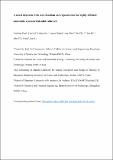A novel electrode with multifunction and regeneration for highly efficient and stable symmetrical solid oxide cell
Abstract
Symmetrical solid oxide cells (SSOCs) have been extensively recognized due to their simple cell configuration, low cost and reliability. High performance electrode is the key determinant of SSOCs. Herein, a multifunctional perovskite oxide La0.6Ca0.4Fe0.8Ni0.2O3-δ (LCaFN) is investigated as electrode for SSOCs. The results confirm that LCaFN shows excellent oxygen reduction reaction (ORR), oxygen evolution reaction (OER), carbon dioxide reduction reaction (CO2-RR) and hydrogen oxidation reaction (HOR) catalytic activity. In SOFC mode, the SSOCs with LCaFN achieve good electrochemical performance with maximum power density of 300 mW cm−2 at 800 °C. For pure CO2 electrolysis in SOEC mode, polarization resistance of 0.055 Ω cm2 and current density of 1.5 A cm−2 are achieved at 2.0 V at 800 °C. Besides, the cell shows excellent stability both in SOFC mode and SOEC mode. Most importantly, SSOCs with symmetrical LCaFN electrodes show robust and regenerative performance under anodic or cathodic process during the switching gas, showing the great reliability of the SSOCs. The results show that this novel electrode offers a promising strategy for operation of SSOCs.
Citation
Tian , Y , Liu , Y , Jia , L , Naden , A , Chen , J , Chi , B , Pu , J , Irvine , J T S & Li , J 2020 , ' A novel electrode with multifunction and regeneration for highly efficient and stable symmetrical solid oxide cell ' , Journal of Power Sources , vol. 475 , 228620 . https://doi.org/10.1016/j.jpowsour.2020.228620
Publication
Journal of Power Sources
Status
Peer reviewed
ISSN
0378-7753Type
Journal article
Description
Authors acknowledge financial support from National Key Research & Development Project (2016YFE0126900), National Natural Science Foundation of China (51672095, U1910209), and China Scholarship Council (201806160178). The work is also partially supported by State Key Laboratory of Materials Processing and Die & Mould Technology, Huazhong University of Science and Technology (P2019-004).Collections
Items in the St Andrews Research Repository are protected by copyright, with all rights reserved, unless otherwise indicated.

